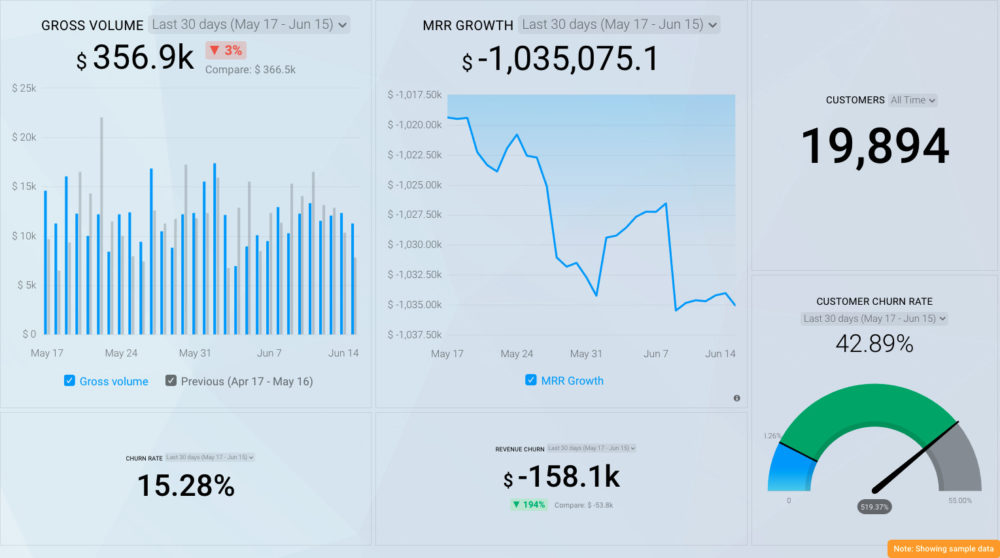Table of contents
When creating a comprehensive business report for your company, most of your time and energy will go into writing the main section of your report.
Once you come to the conclusion, you will probably be exhausted and you may feel the urge to just ‘wrap it up’ as soon as possible.
This can be a costly mistake.
Your conclusion carries the same importance as all the other sections of the report since it leaves the final impression on the reader.
How you conclude your business report has a direct impact on the way in which the readers will respond to the important information you gathered.
The business report may be spectacular, but without a convincing conclusion, all your efforts may deteriorate.
In this article, we are going to teach you how to write a compelling conclusion that will leave a huge impression on all your readers.
- What Is Conclusion in Business Report Writing?
- How Do You Write a Conclusion for a Report?
- Types of Business Report Conclusions
- Improve Business Reporting with Databox
What Is Conclusion in Business Report Writing?
No matter which type of business report you have written, you will need a good conclusion to sum up all the critical information.
A business report conclusion is the last section of the document used for summarizing the most important information, providing a final word to the readers.
Through the conclusion, you are able to convey the main message of your business document. You use it to outline the report as a whole, remind the readers of the main pain points, and present the key findings and decisions.
Depending on whether you have written a shorter or longer business report, the conclusion length may vary, but it should always be included. It is a sign of good organization and it can make the readers understand the pain points much easier.
To put it simply, the conclusion is supposed to create the impression among the readers that the purpose of the report has been achieved.
Business report conclusions have a lot of similarities to executive summaries, which is why a lot of people tend to confuse these two.
However, there are some important things that differentiate them. These include:
- Executive summaries are mainly focused on displaying what the report will be about, while conclusions are an overview of what was discussed in the report.
- Executive summaries provide readers with a broad overview of the business report, while the conclusion summarizes the key pain points and most important data.
- Executive summaries should convince the readers to continue reading the report, while the conclusion should persuade them to take certain action.
- Conclusions tend to include CTAs (Call to Action), which isn’t the case with executive summaries.
Related: Executive Reporting: Management Reporting Best Practices & Report Examples
How Do You Write a Conclusion for a Report?
Now that you understand what a conclusion is and why it’s so important to include it in your report, let’s show you how you can write the perfect one and impress your readers.
Follow these steps to create a great business report conclusion.
- Choose the Position
- Include the Right Information
- Summarize the Contents
- Facts and Statistics
- Maintain a Positive Tone
- Develop a CTA
- Proofread
Choose the Position
There are two places where conclusions are most commonly placed – at the end of the executive summary and at the end of the entire report.
For business plan reports, the common practice is to place the conclusion at the end of the executive summary.
This way, you make the first step through the executive summary template and introduce the plan’s main pain points and funding needs. Then, you create a conclusion to summarize these numbers to your potential investors, which directly impacts their decision to go over the executive summary once more, this time reading it more thoroughly.
For other types of business reports, the conclusion will generally be placed at the end of the whole report. Established companies use these business reports to track performances and data from important departments, which is why the conclusion should primarily focus on briefly reviewing the key metrics you included and emphasizing the company’s main strengths.
Include the Right Information
The information you put into the conclusion also depends on whether you are a new startup looking to attract investments or an established company that wants to track performances and asses objectives.
To raise money, startups should include this type of information:
- Financial needs
- The benefits of their product and how it can affect the market
- Target audience/ideal customer persona
- How the product can attract new customers
- Marketing and sales strategy
- Competitive landscape and analysis
- The expertise of the main members of the company
- Financial forecasts (next 3-5 years)
- Launching plan
Existing companies should include information such as:
- Mission statement
- Performance history
- Data that showcases business growth
- Financial summary
- Overall goals and objectives
While these types of details are important, they aren’t universal for all reports. Your primary goal should be to include the most important data from your specific document and keep the conclusion concise and understandable.
PRO TIP: How to Track the Right Metrics for Your SaaS Company
It’s not easy to know which KPIs to track for sales, marketing, and customer success in a SaaS company. There are many possibilities, and so much to do! Why not start with the basic metrics that determine the health of your company?
- Sales (Gross) Volume: How much revenue did your sales team bring in this month, this quarter, or this year?
- MRR Growth: How fast are you growing revenues from recurring subscriptions?
- Customers: How many customers do you have right now?
- Customer Churn Rate: What’s your customer churn rate, and how much revenue have you lost to churn?
If you want to track these in Stripe, you can do it easily by building a plug-and-play dashboard that takes your Stripe customer data and automatically visualizes the right metrics to allow you to monitor your SaaS revenue performance at a glance.
You can easily set it up in just a few clicks – no coding required.
To set up this Stripe dashboard, follow these 3 simple steps:
Step 1: Get the template
Step 2: Connect your Stripe account with Databox.
Step 3: Watch your dashboard populate in seconds.
Summarize the Contents
The best way to convey your main message is by explaining it in detail throughout the business report and then summarizing it to recap the main points.
When creating the business report, take notes of the most important information that you should later highlight in the conclusion.
Make sure to avoid any extra details since they are already provided within the report. Only include the key points that explain why the business report itself is useful to the company.
Also, don’t use any additional information that you didn’t include in the report. This can only confuse your readers and send mixed messages.
Facts and Statistics
You should prepare some facts, statistics, and data to support the statements in your conclusion. No matter if the reader is a potential investor or the key stakeholders in your company, you will want to include some evidence to back up your claims.
This makes the conclusion much more convincing and the audience will see that your forecasts aren’t based only on vague assumptions.
Maintain a Positive Tone
The tone in your conclusion should match the rest of the document and the best way to leave an impression on the audience is by using a professional and positive tone throughout the whole report.
After going through the conclusion, the readers should feel interested and enthusiastic to support the growth of your organization.
Make sure you exude confidence by using strong and active language.
Develop a CTA
Including a call to action at the end of your conclusion helps you persuade the readers to support the goals you set up.
This can be anything from “Join us at X enterprises” or “Invest in X and become a part of the success”.
A good CTA includes strong action words through which you emphasize the benefits of investors joining your firm or key stakeholders supporting your objectives.
Proofread
After you are finished writing the conclusion, go over it once again to make sure there aren’t any spelling, grammar, or punctuation mistakes you overlooked. The conclusion should be clear, precise, and easy to go understand.
You can even ask a colleague or a friend to read it since it’s always helpful to have an extra set of eyes. Ask their opinion on how the conclusion makes them feel and whether it was easy to go through.
Types of Business Report Conclusions
As we said, depending on which type of business report you have written and what is included in it, there are a few different types of conclusions you should differentiate.
Let’s walk you through them.
- Conclusion with a Prediction
- Conclusion with a Major Problem
- Conclusion with a Quote
- Conclusion with a Summary
Conclusion with a Prediction
If your report focuses on a decision or strategy that already took place, you can write a conclusion that predicts the outcomes of that specific strategy.
You can include financial forecasts, sales expectations, and overall growth predictions. Make sure to also back up your predictions with sufficient evidence.
Conclusion with a Major Problem
Writing this type of conclusion can be a bit tricky. You don’t want to come off strong and repeat the same issue over and over again. However, you do want the readers to take the issue seriously and realize why it is important that everyone focuses on solving it as soon as possible.
Be direct, but also lenient. Describe why that issue is important and provide a few ways on how you can solve it. Keep it brief and memorable.
Conclusion with a Quote
Ending your conclusion with a powerful quotation can leave a great impression on the readers. However, you should be very careful when choosing the right quote.
You can’t just throw in some saying from Shakespeare and wrap it up. It is best to quote someone influential in the industry in such a way that it reinforces your message.
Conclusion with a Summary
When writing your short but meaningful summary, don’t go into detail about your main points again. Keep it as brief as possible and only remind the readers of the most important information.
Also, you should remember that a conclusion doesn’t have to include only one of these things. Mixing up a summary and a prediction can be a powerful combination, so always try to figure out a few different ways to convey your message and then choose the right one.
Improve Business Reporting with Databox
Business reporting is one of the indispensable activities within a company, but it is also one of the most time-consuming.
The traditional way of creating business reports has always been a daunting task for executives around the world – hours spent copying and pasting, checking different tools for data, tracking the performance each week, and constantly updating the reports manually.
Databox has introduced a new way of doing things.
With our customizable dashboards, you will save both time and energy by tracking all of your important data in one place and updating it in real-time. You can connect your favorite devices and monitor business performances in one comprehensive report.
Additionally, you will also be able to prepare beautiful and understandable reports by using some of our advanced visualization tools. With just a few clicks, you can visualize all of the key metrics and turn them into professional-looking graphs and charts.
Sign up for a free trial and improve your business reporting process in no time.














